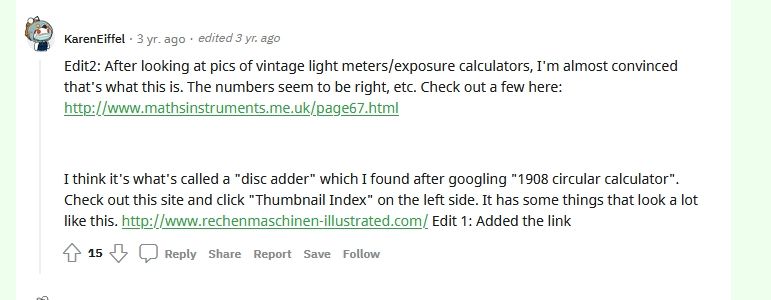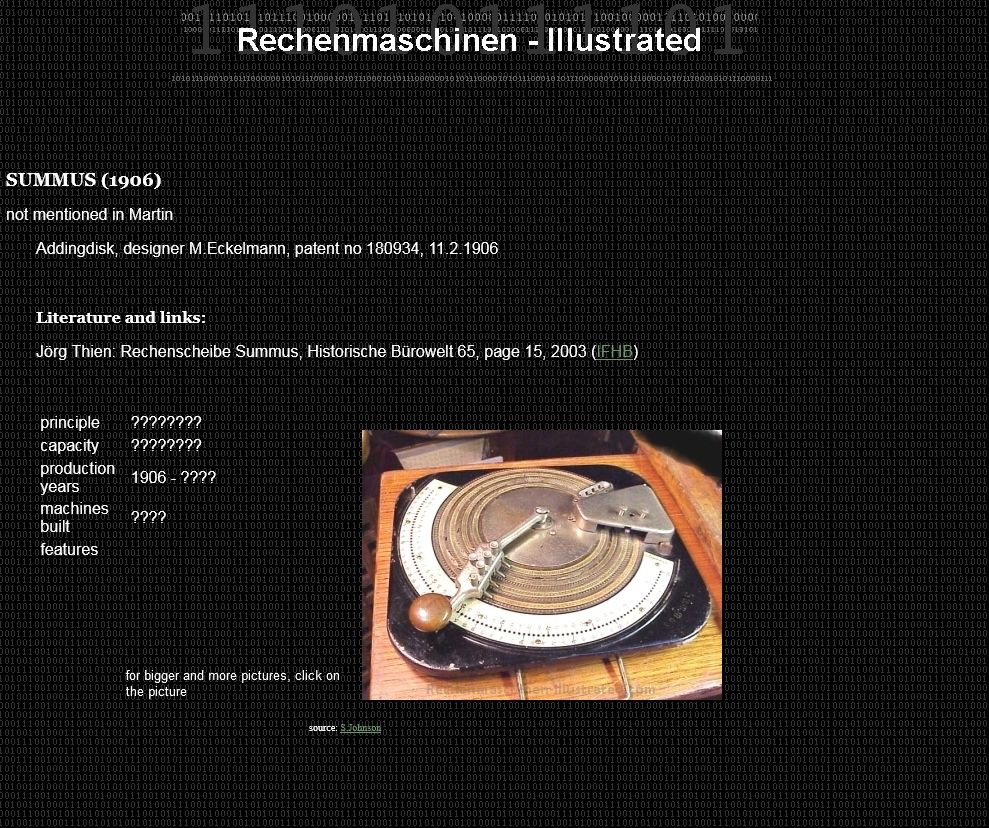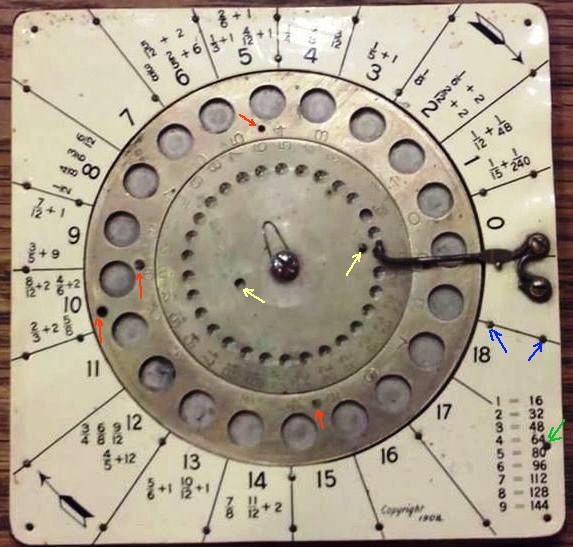Yes = I think the larger, blind holes are simply to take a finger-tip or the back end of a pencil, as in the old rotary telephone dials.
The video referred to earlier on shows someone rotating the dial but and manipulating the inner one but that doesn't really help us identify it, I'm afraid. It does show the two rotors are not geared together. Or if they were, it might have been by pins lost long ago. It also shows that at certain points certain holes line up, by revealing the writing-pad under the instrument. Unfortunately the operator had apparently no spotted it, and was turning it too rapidly for me to read it properly.
I've had a reply from the pharmacology historians.
They say it's not to do with medicine – adding that to music and textiles as trades it's not for. They did though suggest something I don't think has been looked at yet, that the instrument is not for working in one system, but for converting between two systems of… what? A measurement system now lost?
'
Start a new dig……
For example, one Vedro of water = 2.7 Imperial Gallons, as does 1 Eimer; but 1 Pood = 3.6 Imp. Gall.; and the Russian Fathom = 7 feet.
(I kid thee not: look in your copy of Fowler's Mechanics' & Machinists' Pocket Book, 1944. Page 30. )
Further rooting established the vedro and pood were Russian; the eimer, Austrian.
My source? I typed those three names and the word "measurement" into the search-bar and as much by luck as intelligent(!) guess, picked on A Manual of Commerce, by William Waterston.
The Google ad (which offers a printed version of this 19C book) opened a table titled General Table of Metrical Equivalents – to Imperial units. Note the adjective does not say or mean "metric". My choice of units was helpfully highlighted.
Only, Waterston gives the Eimer as 12.460 Imp. Gall in Austria, 15.118 Imp Gall in Prussia… While in Russia, 1 Pood was a mass unit = 36.10lbs avoirdupois ("have some peas" ). Ah – that makes sense: 1 Gall weighs 10lbs.
'
Were all these national units undergoing massive revisions even domestically by the 1944 date of Fowler's? It would be logical even without the late-19 and early-20C upheavals across Europe; and Waterston showing for example the Prussians and Rhinelanders had the Morgen (Ger. = "morning"?) for land area, but at 2.63 and 2.10 acres, respectively; while Austria used the Joch (1.42 acres)!
If you scroll up through the bewildering assortment shown in the sample pages, you find metrical evolution occurring in many lands even before the end of the 19C, and the Metric System was already making inroads. France herself invented the metre etc. because, as did other nations, she had suffered a centuries-old trade-by-region measurements conglomerate making even internal commerce increasingly difficult.
France was already metric as we know it, and it's hardly surprising their neighbours especially moved to copy post-Revolutionary France's m,g,l system. Yet she was still though one of several maritime countries using latitude variants of the League whose one length varied by country for nautical distances. For example, her sailors used:
Lea. 1º [divided by] 25. (The standard Nautical Mile now is 1º / 60.)
France also had a "myrametre" = 10km.
At least Britain's engagingly eccentric Imperial units were nation-wide; and the bushel, peck, grain etc were disappearing long before the official move to Metric, now SI, units. Though it lingers: the modern US Gallon was aapparently a 17C Old World, wine-trade version of the Gallon.
So although this does not really get us much further forwards in identifying our neat little device, it does suggest it was really a units converter for merchants generally; but specific to two nation's national metrical or indeed currency units. Waterston shows currency too, was a complete tangle.
Which countries though?
The table shows an incredible labrynth.
'
Interesting that the decimal fractions above are 9s-based but I am not sure if or how they go with the fractions on our curio's scale. We'd need know, really, how the Eimer, Vedro, Pood etc. or other candidate units were sub-divided or multipled. Nor does it explain the 16-times table, but if this device is to suit a national scale, that might not be Russian or Austrian anyway.
Further ferreting, another book – Encylopedia of Scientific Units, Weights and Measures, Francoise Cardarelli, 2012. The Google review frustratringly omits the Russian page but does give a selection of other countries' ancient measures, in tables showing their sub-divisions and multiples. Intriguingly, very many did use ratios expressed (as indeed does Avoirdupois) in single-integer fractions; and some seem to match some of those on this calculator.
'
So I for one, inspired by the pharmacologists, am turning to thinking this was a units- or currency- converter for general commerce between two countries, not a special design tool.
'
Ref:
https://books.google.co.uk/books?id=2ZUTtLOHd1MC&pg=PA186&lpg=PA186&dq=vedro,+eimer,+pood+measurements&source=bl&ots=qntGtNswHe&sig=ACfU3U3KPmH_T-CGdOCwpBLcw1A8fCG4fA&hl=en&sa=X&ved=2ahUKEwiM7_DKurj1AhUSmVwKHU-XD74Q6AF6BAgeEAM#v=onepage&q=vedro%2C%20eimer%2C%20pood%20measurements&f=false
'
Edited By Nigel Graham 2 on 17/01/2022 11:08:19
Farmboy.












